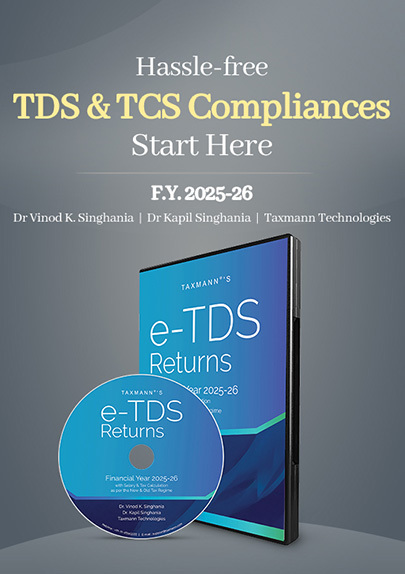Weekly Round-up on Tax and Corporate Laws | 9th to 13th December 2024
- Blog|Weekly Round-up|
- 10 Min Read
- By Taxmann
- |
- Last Updated on 17 December, 2024

This weekly newsletter analytically summarises the key stories reported at taxmann.com during the previous week from December 09th to 13th, 2024, namely:
- Section 50C’s legal fiction not applicable for WDV calculation in claiming depreciation on asset blocks;
- GSTN issued new advisory on difference in value of Table 8A and 8C of Annual Returns FY 23-24;
- Claiming of ITC under wrong head is only a technical mistake committed by assessee: HC;
- SEBI introduces significant changes to LODR norms thereby enhancing governance and transparency of listed entities; and
- Accounting for Software Development Costs with Ind AS 38 Compliance
1. 50C’s legal fiction not applicable for WDV calculation in claiming depreciation on asset blocks
During the year under consideration, the assessee had sold a factory building. The said property appeared as part of a block of assets in the books of account, and depreciation on the block of building was claimed by the assessee for income tax purposes. The stamp duty valuation of the said building was adopted at a much higher value than the actual sale consideration.
The assessee claimed depreciation on the remaining value of the written down value of the block of the building after reducing the actual sale consideration. During the assessment proceedings, the Assessing Officer (AO) held that based on the provision of section 50C, the depreciation should be worked out on the remaining value of the block of the building after reducing the stamp duty value of the building. Accordingly, the AO disallowed the excess depreciation.
On appeal, the CIT(A) upheld the AO’s order. Aggrieved by the order, the assessee filed an appeal to the Mumbai Tribunal.
The Tribunal held that the sole issue in dispute in the ground raised by the assessee was in respect of the computation of the ‘written down value’ (WDV) as per the provision of section 43(6)(c)(i)(B). According to section 32(1)(ii), depreciation on any block of asset is allowed at the rate of percentage prescribed under the rule on the ‘written down value’ of the block of asset. In Explanation 2 to Section 32(1), it is mentioned that for the purpose of sub-section (1), the ‘written down value’ of the block of the asset shall have the same meaning as in sub-section (c) of clause 6 of section 43.
Explanation 4 to Section 32 has prescribed that the expression ‘moneys payable’ and ‘sold’ shall have the same meanings as in the Explanation below sub-section (4) of Section 41.
On perusal of the provisions of section 41(4), it was clear that for the purpose of computing ‘written down value’, the value of the ‘moneys payable’ in respect of the property sold has to be reduced from opening written down value of block of the asset. The inclusive definition provided for insurance, compensation, etc. received in respect of the said property and the price for which the property is sold.
In the instant case, the sale consideration of the building sold is not more than the opening written down value (WDV) of the block, including the new building acquired. Therefore, section 50 does not result in any short-term capital and, hence, does not apply to the present facts of the case until all the buildings under the block are sold. In that case, section 50 would be attracted, and the AO could have substituted the sale consideration received by stamp duty valuation of the property.
Therefore, the deeming fiction of section 50C cannot be extended while working out the written-down value to claim deprecation on the block of the asset. The legislature has created the legal fiction under section 50C to compute the capital gain on selling capital assets. Similarly, while computing the profits and gains of the business, the legislature has introduced a legal fiction under section 43CA for substantiating the sale consideration by the Stamp Duty Value while transfer of assets other than the capital asset, i.e., stock-in-trade, but no specific fiction has been created while computing deprecation on the block of the assets for substantiating the sale consideration by the Stamp Duty Valuation Authority.
Thus, the present definition of the ‘moneys payable’ cannot be construed as including as the Stamp Duty Valuation of the property and, therefore, the legal fiction for substantiating the sale consideration by the Stamp Duty Value created under either section 50C or section 43CA cannot be extended to section 32 for claiming depreciation on the block of the asset. Accordingly, the disallowance made by the AO was deleted.
Read the Ruling
2. GSTN issued new advisory on difference in value of Table 8A and 8C of Annual Returns FY 23-24
The GSTN has noted that several concerns have been raised regarding mismatch between the values of table 8A and 8C of Form GSTR-9 for FY 23-24. Now, the GSTN has issued an advisory to inform that for FY 22-23 in table 8A of Form GSTR-9, values were getting auto populated from GSTR-2A; however, for FY 23-24 the same values are being auto populated from GSTR-2B. Therefore, to some extent, in Form GSTR-9 of FY 23-24, values in Table 8A will be inflated.
Hence, aforesaid value need not to be reported in the table 8C and Table 13 of GSTR-9 for FY 23-24. This is in line with the instruction number 2A given for the notified form GSTR 9 which states that Table 4, 5, 6 and Table 7 should have the details of current FY only. In this regard, GSTN Update dated December 9th, 2024 has been issued.
Read the GSTN Advisory
3. Claiming of ITC under wrong head is only a technical mistake committed by assessee: HC
The High Court of Kerala has recently held that there was no wrong availment of ITC if the appellant inadvertently showed the IGST component as nil and added bifurcated CGST and SGST components of IGST to existing figures showing eligible CGST and SGST credit. This ruling is given in the case of Rejimon Padickapparambil Alex v. Union of India [2024] 169 taxmann.com 152 (Kerala).
Facts
The assessee was a registered dealer and received various inward supplies of goods, both inter-state and intra-state. For the inter-state inward supplies, on which IGST was paid by the supplier, the assessee had to avail input tax credit. While filing Form GSTR-3B, instead of showing the IGST component in the eligible credit details, the assessee inadvertently showed the IGST component as nil and added the bifurcated CGST and SGST components of IGST to the existing figures showing eligible CGST and SGST credit.
This resulted in a mismatch between Form GSTR-2A and Form GSTR-3B. The Assessing Authority (AA) contended that the mismatch had resulted in the assessee utilising ‘unavailable credit’ towards payment of CGST and SGST on outward supplies. Further, the authority issued a notice demanding the return of the CGST/SGST amounts allegedly utilised in excess by the assessee.
High Court
The Kerala High Court held that Section 73 of the GST Act was attracted only when it appeared to a proper officer that any tax had not been paid or short paid or erroneously refunded or where input tax had been wrongly availed or utilised for any reason. In the instant case, there had been no wrong availment of ITC, and the only mistake committed by the assessee was an inadvertent and technical one. The mistake was also insignificant because there was no outward supply attracting IGST that was effected by him. Therefore, the Court set aside the order of AA and allowed the writ petition by quashing the demand order.
Read the Ruling
4. SEBI introduces significant changes to LODR norms thereby enhancing governance and transparency of listed entities
On December 12, 2024, SEBI notified the SEBI (Listing Obligations and Disclosure Requirements) (Third Amendment) Regulations, 2024. The significant changes include (a) amendments to ‘Related Party Transaction’ norms, (b) enhanced ‘compliance officer’ norms for listed entities, (c) amendments to ‘Secretarial Audit and Secretarial Compliance Report’ and (d) ratification of related party transactions by Independent Directors. These changes aim to strengthen governance, enhance transparency and ensure stricter compliance by listed entities. Some of the key changes in detail are as follows –
4.1 ‘Acceptance of deposits by banks’ and ‘retail purchases by directors or employees’ will not be considered as RPT– [Regulation 2(1)(zc)]
SEBI has introduced amendments to Regulation 2(1)(zc) regarding related party transactions, by adding two exceptions. Thus, the following will not be considered as related party transactions.
- Acceptance of current account deposits and saving account deposits by banks in compliance with the directions issued by the RBI or any other central bank.
- Retail purchases from any listed entity or its subsidiary by its directors or its employees, without establishing a business relationship and at the terms which are uniformly applicable/offered to all employees and directors.
The amendment streamlines compliance for banks and listed entities by excluding routine transactions such as acceptance of deposits by banks and retail purchases by employees and directors. This reduces unnecessary regulatory scrutiny over these transactions, provided they adhere to prescribed conditions, enabling smoother operations while maintaining transparency.
4.2 SEBI strengthens the position of Compliance Officer – [Regulation 6(1)]
SEBI has notified key changes in Regulation 6 relating to the ‘Compliance Officer and his/her obligations’. As per the amended norms, a Compliance Officer must be an officer, who is in whole-time employment of the listed entity, not more than one level below the board of directors, and must be designated as a Key Managerial Personnel (KMP). The amendments strengthen governance by ensuring that the Compliance Officer holds a significant position within the organisation as a KMP.
4.3 Amendments to ‘Secretarial Audit and Secretarial Compliance Report’ – [Regulation 24A]
SEBI has introduced certain amendments to the Secretarial Audit and Secretarial Compliance Report. The amendments are as follows –
(a) Appointment of Peer reviewed Company Secretary for Secretarial Audit
Every listed entity and its material unlisted subsidiaries must undertake a secretarial audit conducted by a Peer-Reviewed Company Secretary and annex a secretarial audit report with the annual report of the listed entity.
“Peer Reviewed Company Secretary” means a Company Secretary in practice, who is either practicing individually or as a sole proprietor or as a partner of a Peer Reviewed Practice Unit, holding a valid certificate of peer review issued by the Institute of Company Secretaries of India.
(b) Appointment of Secretarial Auditor
The listed company must appoint a Secretarial Auditor on the recommendation of the board of directors of the company.
(c) Tenure of Secretarial Auditor
A listed entity must appoint or re-appoint an individual as Secretarial Auditor for not more than one term of five consecutive years and a Secretarial Audit firm as Secretarial Auditor for not more than two terms of five consecutive years, with the approval of its shareholders in its Annual General Meeting.
Further, any association of an individual or firm as the Secretarial Auditor of a listed entity before March 31, 2025, will not be counted when calculating their tenure.
(d) Removal or Resignation of Secretarial Auditor
The entity may remove the Secretarial Auditor with the approval of its shareholders in its Annual General Meeting, or the Secretarial Auditor may resign from his office in that listed entity before the completion of the term as Secretarial Auditor.
(e) Eligibility, Qualifications and Disqualifications of Secretarial Auditor
Only a peer reviewed Company Secretary Firm including a limited liability partnership whose majority of partners are practising in India or an individual is eligible to be appointed as Secretarial Auditor and who has not incurred any disqualifications as specified by the Board. However, if the appointed auditor incurs any of the disqualifications after the appointment, then such an auditor must vacate the office, and the vacation shall be deemed to be a casual vacancy.
4.4 Ratification of ‘Related Party Transactions by Independent Directors’ – [Regulation 23(2) & 23(3)]
SEBI has introduced an amendment to Regulation 23(2) concerning Related Party Transactions. New clauses (e) and (f) have been added to the second proviso of the regulation. As per the amended norms, the members of the audit committee, who are independent directors, can now ratify related party transactions within three months from the date of the transaction or in the immediate next meeting of the audit committee, whichever is earlier, subject to certain conditions.
The following are the conditions for ratification:
- the value of the ratified transaction(s) with a related party, during a financial year shall not exceed Rs 1 crore;
- the transaction is not material in terms of policy on materiality of related party transactions;
- rationale for inability to seek prior approval for the transaction must be placed before the audit committee at the time of seeking ratification;
- the details of ratification must be disclosed along with the disclosures of related party transactions;
- any other condition as specified by the audit committee.
Further, remuneration and sitting fees paid by the listed entity or its subsidiary to its director, key managerial personnel, or senior management (except those part of the promoter or promoter group) will not require the approval of the audit committee, provided that these payments are not material as per the policy on materiality of related party transactions.
Also, the Audit committee may grant omnibus approval for related party transactions proposed to be entered into by the listed entity or its subsidiary.
The amendment provides greater flexibility in handling related party transactions by allowing independent directors to ratify such transactions within three months or in the immediate next meeting. This reduces procedural delays while ensuring that the transactions remain within the defined limits and are adequately disclosed.
Read the Notification
5. Accounting for Software Development Costs with Ind AS 38 Compliance
Organizations often face challenges when accounting for costs incurred in the development of software, particularly when the software is intended for internal use. Key issues include differentiating between the research and development phases, determining whether costs meet the recognition criteria for intangible assets, and ensuring compliance with relevant accounting standards. These challenges arise due to the evolving nature of software development projects, which often involve significant initial research, technical evaluations, and subsequent development activities.
Ind AS 38, Intangible Assets provides specific guidance on the recognition and measurement of intangible assets, particularly for internally generated intangible assets like software. According to the standard, an intangible asset shall be recognized only when it is probable that future economic benefits will flow to the entity, and the cost of the asset can be measured reliably. Costs incurred during the research phase must be expensed as they arise because, at this stage, it is not possible to demonstrate the existence of an asset that will generate probable future economic benefits. Conversely, costs incurred during the development phase can be capitalised, provided that specific criteria are met. These criteria include demonstrating technical feasibility, intent, and ability to complete the asset and the reliable measurement of costs attributable to the asset.
In software development, activities such as market research, user feedback analysis, and feasibility studies are part of the research phase. Since these are exploratory in nature, their costs must be recorded as expenses in the profit and loss account under Ind AS 38. However, when the project progresses to the development phase where the software’s design and functionality are defined, and its completion is technically feasible, costs for tasks such as programming, system integration, and testing can be capitalized as an intangible asset, provided they meet the criteria outlined in the standard.
For example, an organisation decided to develop accounting software to enhance its internal processes. During the initial phase, the company incurred costs related to market analysis and stakeholder interviews. These research phase costs were expensed in accordance with Ind AS 38, as they did not meet the criteria for recognition as an intangible asset. In the subsequent development phase, the organization worked on coding, integrating the software with its existing systems, and implementing security protocols. These development phase costs were capitalized, as they fulfilled the recognition criteria under the standard. By distinguishing between the research and development phases and applying the relevant provisions, the organization ensured compliance with Ind AS 38 and provided an accurate reflection of its financial position.
Read the Story
Disclaimer: The content/information published on the website is only for general information of the user and shall not be construed as legal advice. While the Taxmann has exercised reasonable efforts to ensure the veracity of information/content published, Taxmann shall be under no liability in any manner whatsoever for incorrect information, if any.

Taxmann Publications has a dedicated in-house Research & Editorial Team. This team consists of a team of Chartered Accountants, Company Secretaries, and Lawyers. This team works under the guidance and supervision of editor-in-chief Mr Rakesh Bhargava.
The Research and Editorial Team is responsible for developing reliable and accurate content for the readers. The team follows the six-sigma approach to achieve the benchmark of zero error in its publications and research platforms. The team ensures that the following publication guidelines are thoroughly followed while developing the content:
- The statutory material is obtained only from the authorized and reliable sources
- All the latest developments in the judicial and legislative fields are covered
- Prepare the analytical write-ups on current, controversial, and important issues to help the readers to understand the concept and its implications
- Every content published by Taxmann is complete, accurate and lucid
- All evidence-based statements are supported with proper reference to Section, Circular No., Notification No. or citations
- The golden rules of grammar, style and consistency are thoroughly followed
- Font and size that’s easy to read and remain consistent across all imprint and digital publications are applied








 CA | CS | CMA
CA | CS | CMA
